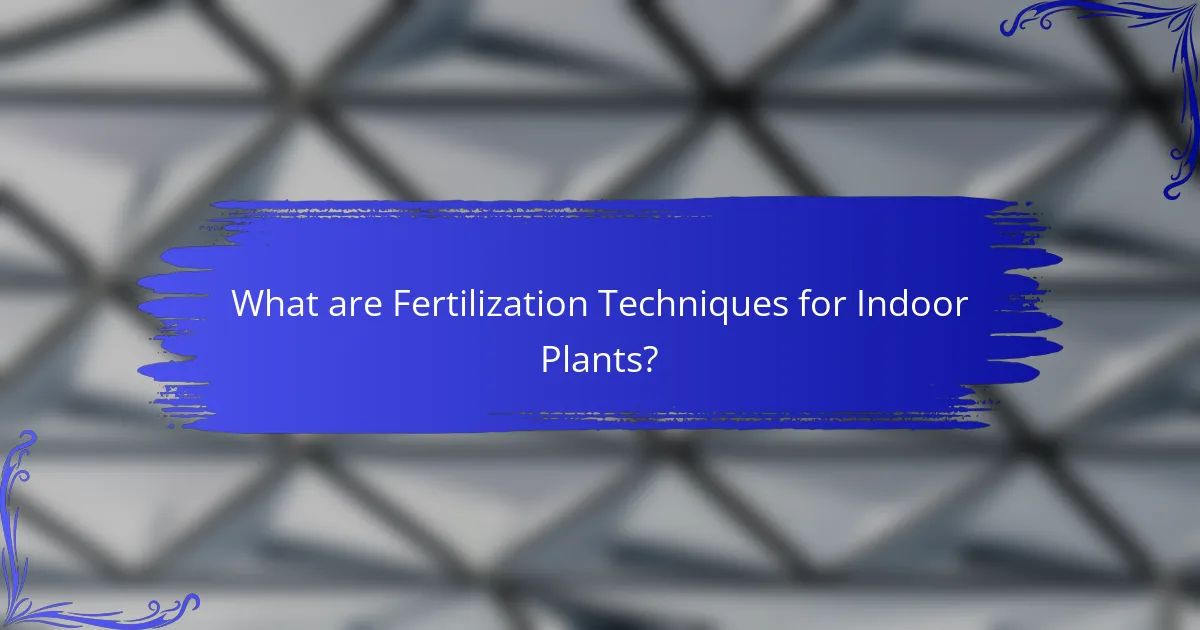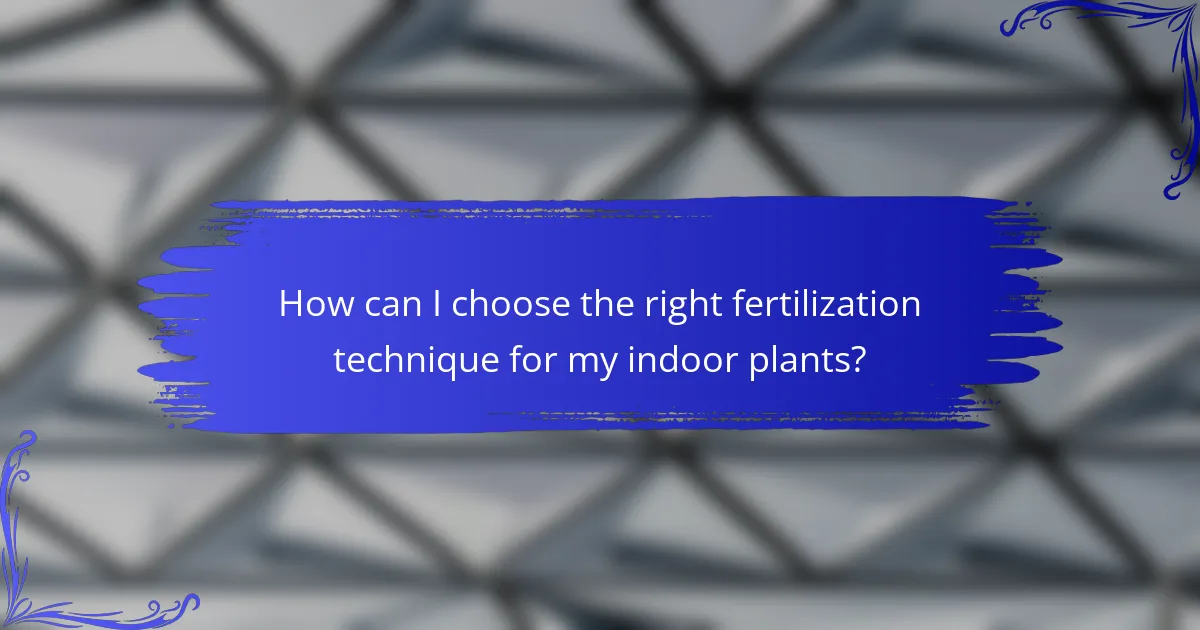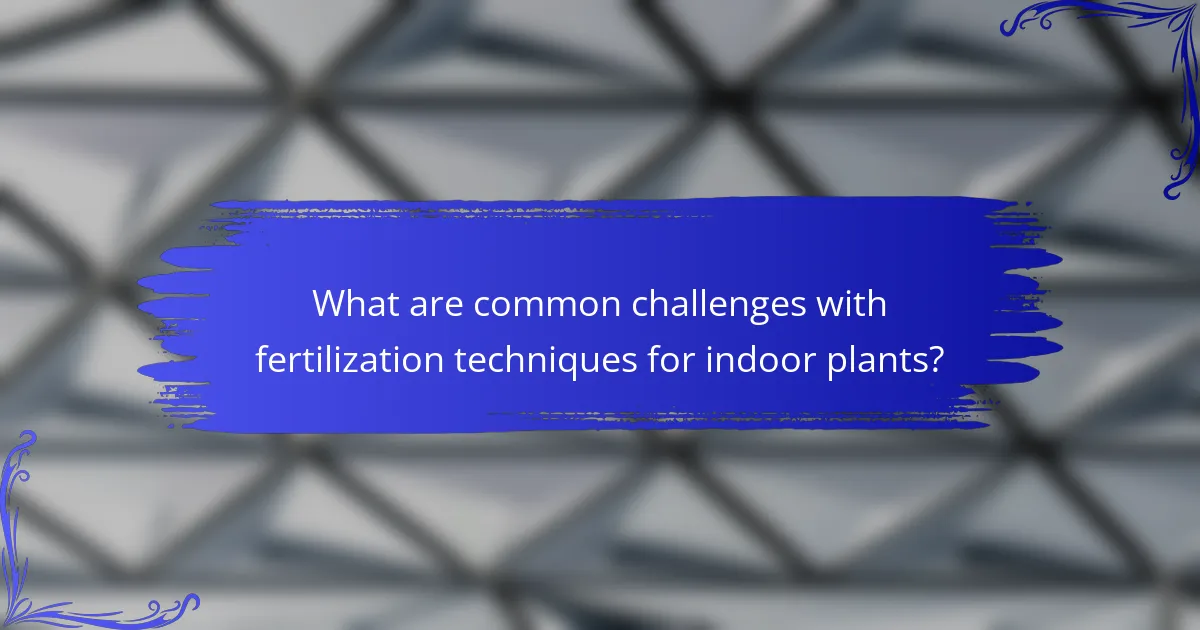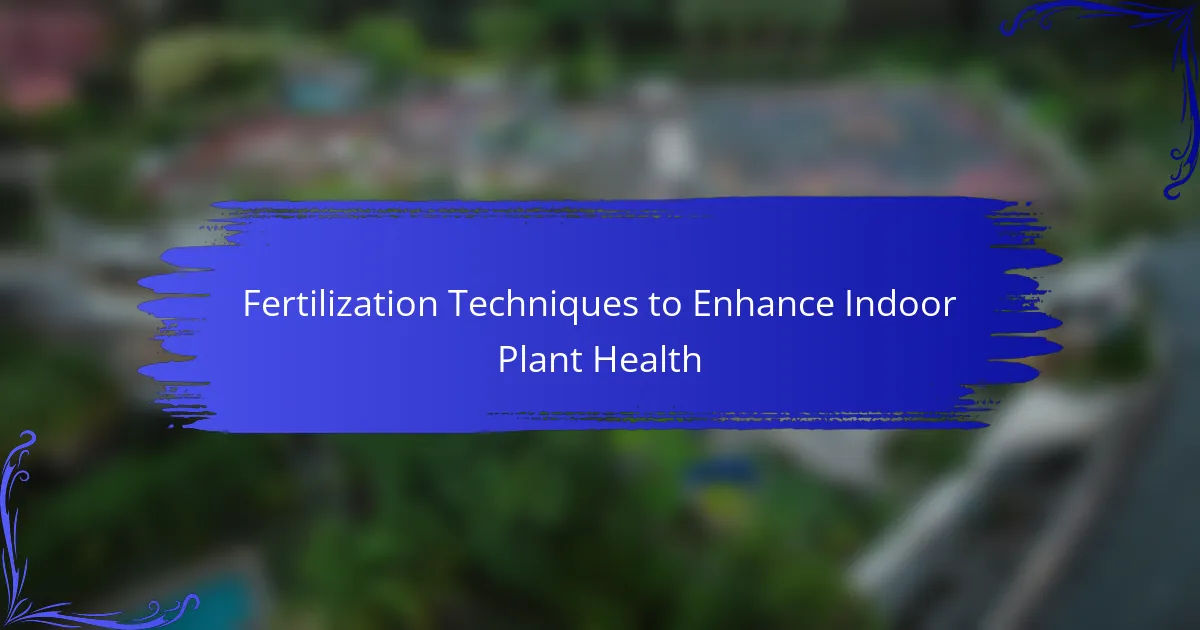Fertilization techniques for indoor plants play a crucial role in promoting plant health and growth. Key methods include liquid fertilization, granular fertilization, and slow-release fertilizers, each with unique application processes and benefits. Organic options like compost and worm castings enhance soil health while providing essential nutrients. Selecting the appropriate fertilization technique involves assessing specific plant needs, conducting soil tests, and timing applications correctly to avoid common challenges such as over-fertilization and nutrient imbalances. Understanding these factors is essential for maintaining vibrant and healthy indoor plants.

What are Fertilization Techniques for Indoor Plants?
Fertilization techniques for indoor plants include liquid fertilization, granular fertilization, and slow-release fertilizers. Liquid fertilization involves mixing water-soluble nutrients with water and applying it directly to the soil. This method allows for quick absorption by the plants. Granular fertilization consists of solid nutrients that are spread on the soil surface. Water is required to activate the nutrients for plant uptake. Slow-release fertilizers provide nutrients over an extended period. They reduce the frequency of applications needed. Additionally, organic fertilizers can be used, such as compost or worm castings. These enhance soil health and provide essential nutrients. Each technique can be tailored to specific plant needs and growth stages.
How do fertilization techniques impact indoor plant health?
Fertilization techniques significantly impact indoor plant health by providing essential nutrients. Proper fertilization ensures that plants receive the right balance of macronutrients and micronutrients. These nutrients support vital processes like photosynthesis, growth, and flowering. Over-fertilization can lead to nutrient burn, harming plant roots and leaves. Under-fertilization may cause stunted growth and yellowing leaves. Different techniques, such as liquid fertilizers or slow-release granules, affect nutrient availability. Research indicates that using organic fertilizers can improve soil health and microbial activity. Healthy soil contributes to better nutrient uptake, enhancing overall plant vitality.
What are the key benefits of using fertilization techniques?
Fertilization techniques enhance indoor plant health by providing essential nutrients. These nutrients support growth, improve flowering, and increase fruit production. Fertilizers supply nitrogen, phosphorus, and potassium, which are critical for plant metabolism. For instance, nitrogen promotes leafy growth, while phosphorus aids root development. Additionally, potassium enhances overall plant resilience. Studies show that properly fertilized plants can yield 20-30% more produce compared to unfertilized ones. Regular use of fertilization techniques leads to healthier, more vibrant indoor plants.
How do different indoor plants respond to fertilization techniques?
Different indoor plants respond variably to fertilization techniques. For example, leafy greens like pothos thrive on high-nitrogen fertilizers. They show rapid growth and vibrant foliage with regular feeding. Conversely, flowering plants like orchids require balanced fertilizers with lower nitrogen. This promotes blooming rather than excessive leaf growth. Succulents, on the other hand, prefer minimal fertilization due to their drought-resistant nature. Over-fertilizing can lead to root burn in these plants. Research indicates that the timing of fertilization also affects plant health. For instance, applying fertilizer during the growing season enhances nutrient uptake. Each plant species has unique nutrient needs that influence its response to fertilization. Understanding these differences is crucial for optimal indoor plant care.
What types of fertilization techniques are available for indoor plants?
Common fertilization techniques for indoor plants include liquid fertilization, granular fertilization, and slow-release fertilization. Liquid fertilization involves mixing soluble fertilizers with water and applying them directly to the soil. This method allows for quick absorption by the plant. Granular fertilization consists of solid fertilizers that are spread on the soil surface. Watering helps dissolve the granules, releasing nutrients gradually. Slow-release fertilization uses specially coated granules that release nutrients over an extended period. This technique reduces the frequency of applications. Each technique caters to different plant needs and growth stages.
What are the differences between organic and synthetic fertilizers?
Organic fertilizers are derived from natural sources, while synthetic fertilizers are chemically manufactured. Organic fertilizers include compost, manure, and bone meal. These materials release nutrients slowly, improving soil structure and promoting microbial activity. Synthetic fertilizers, such as ammonium nitrate, provide nutrients quickly. They often lead to rapid plant growth but can harm soil health over time. Research shows that organic fertilizers enhance biodiversity in soil ecosystems. In contrast, synthetic fertilizers can cause nutrient runoff, leading to water pollution. Thus, the main difference lies in their sources, nutrient release rates, and long-term effects on soil health.
How can slow-release fertilizers enhance indoor plant growth?
Slow-release fertilizers enhance indoor plant growth by providing a steady supply of nutrients over time. This method reduces the risk of nutrient leaching and ensures that plants receive essential elements consistently. Unlike quick-release fertilizers, slow-release options release nutrients gradually, matching plant uptake rates. Studies show that this can lead to healthier root systems and improved overall plant vigor. Research indicates that plants fertilized with slow-release products exhibit better growth rates and flowering compared to those receiving traditional fertilizers. Additionally, slow-release fertilizers reduce the frequency of application, promoting convenience for indoor gardeners.

How can I choose the right fertilization technique for my indoor plants?
To choose the right fertilization technique for indoor plants, assess the specific needs of each plant species. Different plants require varying nutrients, such as nitrogen, phosphorus, and potassium. Conduct a soil test to determine nutrient levels and pH balance. Based on the results, select a fertilizer that addresses any deficiencies. Consider the form of fertilizer, such as liquid, granular, or slow-release options, based on your watering schedule. Timing is also crucial; fertilize during the growing season for optimal results. Research the recommended fertilization frequency for your plant types. Following these guidelines ensures healthy growth and vibrant indoor plants.
What factors should I consider when selecting a fertilization technique?
Consider the type of plants you are fertilizing. Different plants have varying nutrient needs. Assess the nutrient composition of the fertilizer. A balanced fertilizer typically contains nitrogen, phosphorus, and potassium. Evaluate the growth stage of the plants. Young plants may require different nutrients than mature ones. Determine the form of fertilizer, such as liquid or granular. Liquid fertilizers are often faster acting, while granular fertilizers provide slow-release nutrients. Review the frequency of application. Some techniques require more frequent applications than others. Lastly, consider any specific environmental factors, such as light and humidity, that may affect nutrient uptake.
How does plant type influence the choice of fertilization technique?
Plant type significantly influences the choice of fertilization technique. Different plants have varying nutrient requirements based on their growth habits and physiological characteristics. For instance, flowering plants often require higher phosphorus levels for blooming, while leafy greens benefit from nitrogen-rich fertilizers for foliage growth. Additionally, cacti and succulents thrive on low-nutrient fertilizers due to their adaptation to arid environments.
Moreover, the growth stage of a plant impacts fertilization needs. Seedlings may require a balanced fertilizer for initial growth, while mature plants might need specific nutrient ratios tailored to their species. Evidence shows that using the right fertilization technique can enhance plant health and growth rates. For example, research indicates that applying slow-release fertilizers can provide a steady nutrient supply for certain indoor plants, reducing the risk of over-fertilization. Thus, understanding plant types is crucial for selecting the appropriate fertilization technique.
What environmental conditions affect fertilization effectiveness?
Temperature, humidity, light intensity, and soil moisture significantly affect fertilization effectiveness. Optimal temperature ranges between 65°F to 75°F promote nutrient uptake. High humidity levels enhance nutrient absorption, while low humidity can hinder it. Adequate light intensity is essential for photosynthesis, impacting plant growth and nutrient utilization. Soil moisture must be balanced; overly dry or soggy conditions can lead to nutrient leaching or root rot. Research indicates that maintaining these environmental conditions can improve fertilization outcomes, promoting healthier indoor plants.
How can I effectively apply fertilization techniques?
To effectively apply fertilization techniques, start by selecting the appropriate fertilizer type for your indoor plants. Organic fertilizers release nutrients slowly, while synthetic options provide immediate nutrition. Measure the correct dosage according to the manufacturer’s instructions. Over-fertilizing can harm plants, so precision is crucial. Apply fertilizer during the growing season for maximum absorption. Water the plants after fertilization to help distribute nutrients evenly. Monitor plant response to adjust future applications. Research indicates that balanced fertilization improves plant growth and health significantly.
What are the best practices for applying fertilizers to indoor plants?
The best practices for applying fertilizers to indoor plants include selecting the right type of fertilizer. Choose a balanced, water-soluble fertilizer for most indoor plants. Dilute the fertilizer according to the manufacturer’s instructions to prevent root burn. Apply fertilizers during the growing season, typically spring and summer, when plants actively absorb nutrients. Water the plants before fertilizing to ensure even distribution and reduce stress. Avoid fertilizing plants that are stressed or dormant. Monitor plant responses and adjust the frequency of application based on growth patterns. Regularly check soil moisture levels to prevent over-fertilization.
How often should I fertilize my indoor plants for optimal health?
Fertilize indoor plants every 4 to 6 weeks during the growing season. This period typically spans from spring to early fall. During the winter months, reduce fertilization frequency to once every 8 to 12 weeks. Plants actively absorb nutrients when they are growing. A consistent fertilization schedule promotes optimal health and growth. Over-fertilization can lead to nutrient burn and damage. Always follow specific instructions based on the plant type and fertilizer used.

What are common challenges with fertilization techniques for indoor plants?
Common challenges with fertilization techniques for indoor plants include over-fertilization, nutrient imbalance, and improper timing. Over-fertilization can lead to root burn and plant stress. Nutrient imbalance occurs when plants receive excessive amounts of one nutrient while lacking others. This can hinder growth and affect plant health. Improper timing of fertilization can disrupt the plant’s growth cycle. For instance, fertilizing during dormancy can waste nutrients. Additionally, the type of fertilizer used can impact effectiveness. Liquid fertilizers may require more frequent application than granular options. Understanding these challenges is crucial for maintaining healthy indoor plants.
What issues can arise from improper fertilization?
Improper fertilization can lead to several issues in indoor plants. Nutrient imbalances may occur, causing deficiencies or toxicities. Over-fertilization can burn plant roots, leading to wilting and death. Under-fertilization results in stunted growth and yellowing leaves. Soil pH can be altered negatively, affecting nutrient availability. Excessive salts can accumulate in the soil, harming plant health. These problems can ultimately reduce plant vigor and resilience. Research indicates that balanced fertilization is crucial for optimal growth (Source: “Nutrient Management for Healthy Plants,” Journal of Horticultural Science, Smith et al.).
How can over-fertilization harm indoor plants?
Over-fertilization can harm indoor plants by causing nutrient burn. This occurs when excess nutrients accumulate in the soil, leading to salt buildup. Salt buildup can dehydrate plant roots, causing wilting and leaf drop. Additionally, over-fertilization can disrupt the balance of essential nutrients. This imbalance can lead to deficiencies in other vital elements. Symptoms of over-fertilization include yellowing leaves and stunted growth. In severe cases, it can result in plant death. Proper fertilization practices are crucial for maintaining plant health.
What signs indicate that my indoor plants need fertilization adjustments?
Signs that indicate indoor plants need fertilization adjustments include yellowing leaves, stunted growth, and poor flowering. Yellowing leaves often suggest nutrient deficiencies, particularly nitrogen. Stunted growth can indicate that plants are not receiving enough nutrients for development. Poor flowering may result from inadequate phosphorus levels. Additionally, leaf drop can signal over-fertilization or imbalance in nutrients. A white crust on the soil surface may indicate salt buildup from excessive fertilization. Regularly inspecting plants for these signs helps ensure proper nutrient levels are maintained.
What are some practical tips for successful indoor plant fertilization?
Successful indoor plant fertilization requires careful attention to the type and timing of fertilizer. Use a balanced fertilizer that contains equal parts nitrogen, phosphorus, and potassium. This ensures that plants receive essential nutrients for growth. Apply fertilizer during the active growing season, typically spring and summer, when plants need more nutrients. Follow the manufacturer’s instructions for dosage to avoid over-fertilization, which can harm plants. Water the plants before applying fertilizer to prevent root burn. Consider using liquid fertilizers for quick nutrient absorption. Additionally, observe your plants for signs of nutrient deficiency, such as yellowing leaves, and adjust fertilization accordingly. Regularly repotting plants can also refresh the nutrient supply in the soil.
How can I create a fertilization schedule for my indoor plants?
To create a fertilization schedule for indoor plants, determine the specific needs of each plant species. Different plants have varying nutrient requirements and growth cycles. Research the optimal fertilization frequency, typically every 4 to 6 weeks during the growing season. Use a balanced fertilizer suitable for indoor plants, following the manufacturer’s instructions for dilution and application. Monitor plant health and adjust the schedule based on growth responses. For example, yellowing leaves may indicate a nutrient deficiency, suggesting a need for more frequent fertilization. Additionally, consider seasonal changes, as many plants require less fertilization in winter. A well-planned schedule ensures healthy growth and vibrant foliage.
What tools and resources can assist in effective fertilization?
Tools and resources that assist in effective fertilization include soil testers, fertilizers, and watering systems. Soil testers measure pH and nutrient levels. This ensures plants receive the right nutrients. Fertilizers provide essential nutrients like nitrogen, phosphorus, and potassium. They come in various forms such as granules, liquids, and spikes. Watering systems help maintain consistent moisture levels. Drip irrigation systems deliver water directly to the roots. Additionally, compost and organic matter improve soil structure and fertility. These tools and resources collectively enhance indoor plant health and growth.
Fertilization techniques for indoor plants are essential methods used to enhance plant health and growth. The article covers various fertilization methods, including liquid, granular, and slow-release fertilizers, explaining their application and impact on nutrient absorption. It highlights the importance of understanding plant-specific needs, the differences between organic and synthetic fertilizers, and the environmental conditions that affect fertilization effectiveness. Additionally, it addresses common challenges such as over-fertilization and nutrient imbalances, providing practical tips for successful fertilization and scheduling.
